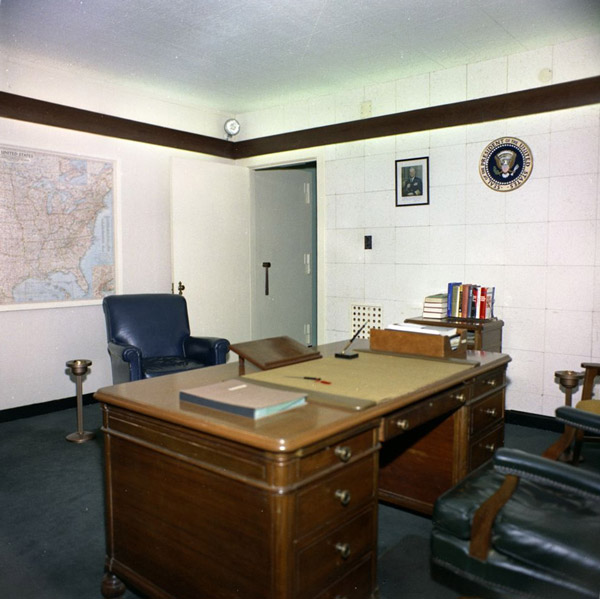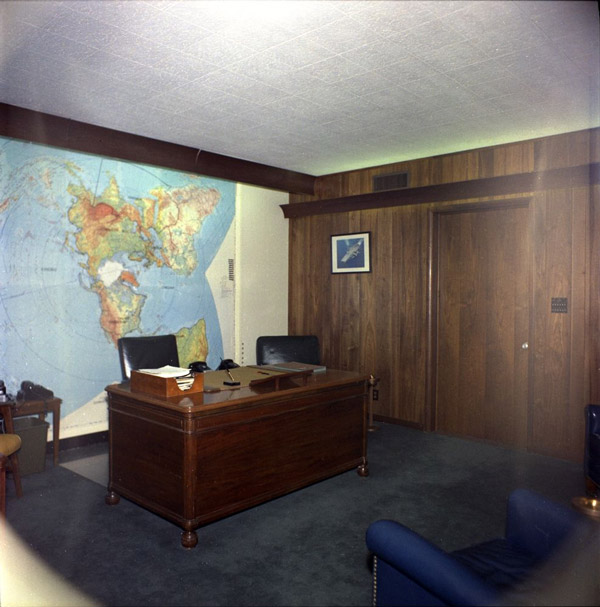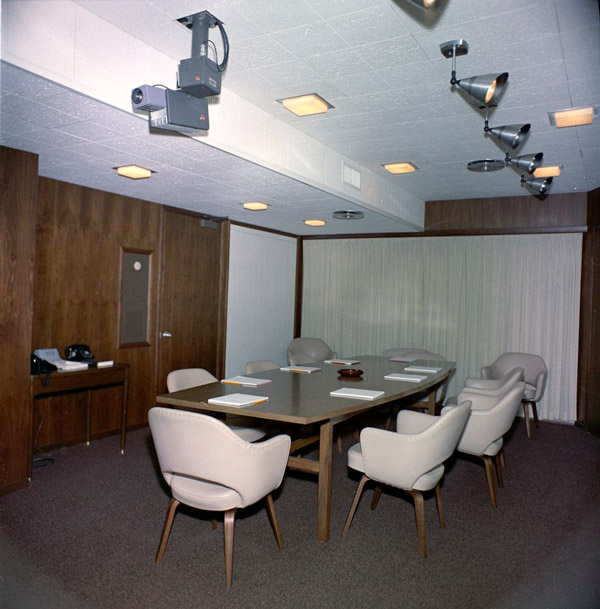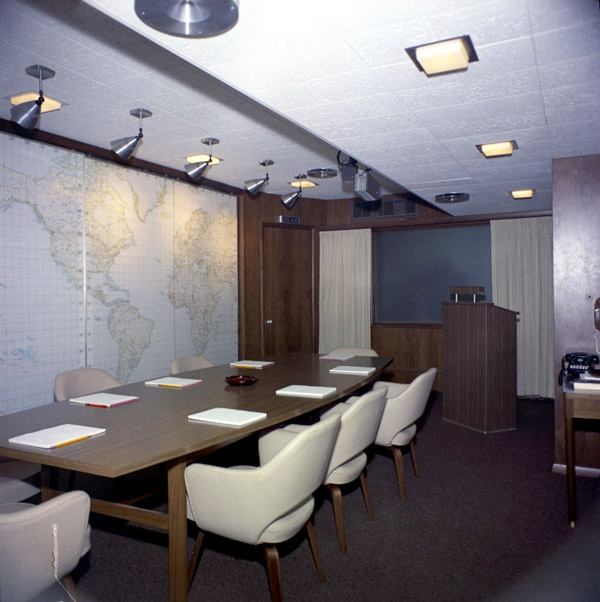
Situation Room

The Situation Room in 2009, looking south (Christopher Morris)
"The Woodshed"The Situation Room is a 5,000 square foot complex of rooms in the ground floor of the West Wing, some of which have windows looking out the west side of the building. It is sometimes called "the woodshed." Contrary to popular belief, the White House Situation Room is not a bunker that is located deep underground. In 2006, the Situation Room underwent a renovation to bring it up to date with new technology. The main conference room now has six flat-screen televisions for secure video conferences, and the technology linking them to generals and prime ministers around the globe makes it less likely that the encrypted voices and images will go black (which happened regularly in connections to Baghdad). Officials found the old room’s wood-paneled walls too noisy, making it hard to hear for those listening in via video or telephone. The new room has less mahogany and more of what officials describe as "21st century whisper wall." The NSC watch officers, who were previously seated so they stared at walls rather than each other, are now seated on two tiers of curved computer terminals that can be fed both classified and unclassified data from around the country and the world. And, where the old Situation Room suite had only two secure video rooms, the new one has five and a direct, secure feed to Air Force One, a better fit for President Bush personally. The area also features privacy booths for phone calls, windows with privacy glass (frosted at the flip of a switch), and procedures and technology to prevent unauthorized cell phone calls and text messaging. During the renovation, workers unearthed several relics of the chamber’s past: from coaxial cables to columns and a frame window left over from the old sunken courtyard that was built by Franklin Delano Roosevelt and later covered by new construction. NSC SecretariatThe staff of the Situation Room—primarily the National Security Council (NSC) Secretariat—helps the president connect with intelligence agencies and important people overseas. The "Sit Room" staff is composed of approximately 30 personnel, organized around five "watch teams" that provide 7-day, 24-hour monitoring of international events and brief the president every day. A typical watch team includes three duty officers, a communications assistant, and an intelligence analyst. Arranging secure international phone calls for the president is one of the more routine and difficult tasks for the Situation Room staff, but they handle a variety of requests for information. President Kennedy once told the Situation Room staff that he wanted every Time and Newsweek magazine from the past year at his bedside in Hyannis Port (his Massachusetts home) by the time he got up the next morning. By 4 AM, the copies were on a plane and the deadline was met. Although meetings in the conference room are usually chaired by the national security advisor, the director of central intelligence starts the dialogue with an overview of the latest information on the crisis. Then each principal voices his or hr view on the situation, and the national security advisor tries to steer the group to a consensus. Origin and UseThe Situation Room was born out of frustration on the part of President Kennedy after the failed Bay of Pigs invasion. He felt that he could no longer trust the information coming to him from the various sectors of the nation's defense departments. McGeorge Bundy, President Kennedy's national security advisor created the Situation Room in May 1961. Bundy secured the funds and secured the space: the Truman-era bowling alley was removed. Under the president's orders, every department of the defense sector had to feed the Situation Room staff their information, day and night. Early on, a lone CIA intelligence analyst worked a 20-hour shift in the Situation Room, sleeping on a cot there during the night. Not all presidents use the room in the same way. John Kennedy spent most of his time during the Cuban missile crisis in the Oval Office or the Cabinet Room and would go down to the Situation Room only to read the teletype. Lyndon Johnson used the room so often during the Vietnam War that he left his Oval Office chair down there. Presidents Nixon and Ford almost never used the room. George HW Bush and Bill Clinton used it often. In most cases, a visit from the president is a formal undertaking. But George HW Bush would often call and ask if he could come in and say hello and see what was happening in the world. Among the most important changes in the 2006 renovation was the expansion of its use beyond the National Security Council to also include the Homeland Security Council and the White House chief of staff’s office. A door in the Situation Room gives access to a staircase that leads up to the Swimming Pool cabana, a feature requested by Gerald Ford to allow the first family to enter the pool area without crossing the south lawn. |
More Images

Former President Clinton with the president and vice-president in 2009 (White House - Pete Souza)

The Situation Room in 2009, looking northwest (White House - Pete Souza)

Actor Brad Pitt visits the Watch Center in 2009 (Mary)

One of the new privacy telephone booths in 2007 (Getty Images - Chip Somodevilla)

Ribbon cutting ceremony for the new main conference room in 2007 (White House - Eric Draper)

British Prime Minister Tony Blair joins President Bush in the new main conference room in 2007 (White House - Eric Draper)

The newly-finished President's Briefing Room in 2007 (White House - Eric Draper)

The newly-finished President's Briefing Room in 2007 (Time)

A newly-finished small conference room in 2007 (Getty Images - Chip Somodevilla)

The president's chair in the main conference room in 2007 (Getty Images - Chip Somodevilla)

The unfinished renovation to the conference room in December 2006 (Time - Christopher Morris)

The unfinished renovation to a mid-size conference room in December 2006 (New York Times - Doug Mills)

The unfinished renovation to a mid-size conference room in December 2006 (AFP/Getty Images - Mandel Ngan)

The unfinished renovation to the NSC watch station in 2006 (Getty Images)

The unfinished renovation to the NSC watch station in 2006 (New York Times - Doug Mills)

President Bush in the Situation Room in 2006, with the video display open (White House)

President Bush in the Situation Room in 2005, with the video display closed (White House)

President Bush in the Situation Room in 2003 (White House)

Bill Clinton in the Situation Room in 2000 (Getty Images - Sharon Farmer)

Bill Clinton in the Situation Room in 1996 (Getty Images - Time - White House)

President Clinton in the Situation Room in 1994 (George Washington University - Clinton Library)

President Reagan in the Situation Room in 1986 (Reagan Library)

President Reagan (and future President Bush) in the Situation Room in 1985 (Reagan Library)

President Reagan's staff in the Situation Room, circa 1982

The National Security Council (NSC) office in the Situation Room, circa 1985, looking northwest

National Security Advisor Henry Kissinger in the National Security Council (NSC) office in the Situation Room, circa 1970

President Johnson looking over a model of Khe Sanh in 1968 (NARA)

The National Security Council (NSC) office in the Situation Room, circa 1967, looking south

President Johnson in the Situation Room, circa 1966 (Johnson Library)

Situation Room office in 1962 (Kennedy Library - Robert Knudsen)

Situation Room office in 1962 (Kennedy Library - Robert Knudsen)

The Conference Room in 1962 (Kennedy Library - Robert Knudsen)

The Conference Room in 1962 (Kennedy Library - Robert Knudsen)

The File Room in 1962; the projector projects images onto the back of the screen in the Conference Room (Kennedy Library - Robert Knudsen)

Breakfast in the Situation Room in 1961 (Kennedy Library - Robert Knudsen)

Breakfast in the Situation Room in 1961 (Kennedy Library - Robert Knudsen)